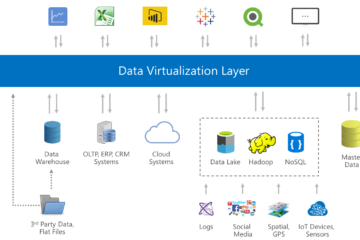A Complete Data Science Solution with Apache Open Source: From Data Integration to Machine Learning and Visualization
In today’s data-driven world, organizations across various sectors, including higher education, are striving to extract value from data to make informed decisions and drive innovation. However, the costs associated with commercial data science software can be prohibitive for many institutions. Fortunately, the Apache Software Foundation (ASF) offers a range of powerful, open-source tools that can build an end-to-end data science ecosystem—from data integration and warehousing to big data processing, machine learning, and data visualization.
This article explores how to leverage Apache’s open-source family of projects to achieve a fully functional data science pipeline. We’ll cover specific Apache tools, their practical applications, and examples of how they work together to form a comprehensive data science stack.

1. Data Integration and ETL with Apache Nifi and Apache Airflow
Data integration is a critical first step for any data science initiative, as it ensures data from multiple sources is collected, cleaned, and transformed to be analytics-ready. Two of Apache’s powerful ETL (Extract, Transform, Load) solutions are Apache NiFi and Apache Airflow.
Apache NiFi
Apache NiFi is a data integration tool specifically designed for automating and managing data flows between different systems. It enables data scientists to design ETL workflows without heavy programming.
- Key Features: Real-time data ingestion, drag-and-drop user interface, support for a wide variety of data formats, and data provenance.
- Use Case: Imagine a university that collects student enrollment data, exam scores, and engagement metrics from various systems. Using Apache NiFi, they can create a data flow to collect, merge, and preprocess this data into a unified format for analytics.
Apache Airflow
Apache Airflow is another excellent tool for workflow orchestration, especially for batch processing and scheduled tasks.
- Key Features: Python-based, scalable, and ideal for complex workflows with dependencies.
- Use Case: Airflow is well-suited for managing ETL pipelines in a higher education setting. For instance, it can be scheduled to extract and load course data from multiple systems overnight, ensuring data is up-to-date for morning analytics.
2.Data Storage and Data Warehousing with Apache Hive and Apache Hudi
For organizations that need to store and organize large amounts of structured and unstructured data, Apache Hive and Apache Hudi provide robust solutions to build traditional data warehouses as well as big data storage solutions.
Apache Hive
Apache Hive is a data warehouse software that allows for the querying and analysis of large datasets stored in a distributed environment, like Hadoop. It uses SQL-like syntax (HiveQL), making it accessible for those familiar with SQL.
- Key Features: SQL compatibility, integration with the Hadoop ecosystem, and support for data summarization and query.
- Use Case: In a university setting, Hive can store historical data on student demographics, course enrollments, and academic performance, providing a centralized repository for analysis.
Apache Hudi
Apache Hudi (Hadoop Upserts Deletes and Incrementals) is designed for big data and allows users to manage incremental data, enabling real-time updates to stored data.
- Key Features: Supports real-time data updates, ACID transactions, and works with both Hive and Spark.
- Use Case: Suppose a university is collecting real-time data on student activity (e.g., logins, course material views). Apache Hudi can ensure that this data is always up-to-date, allowing researchers to perform accurate, real-time analytics.
3. Big Data Processing with Apache Spark
When it comes to processing and analyzing large datasets, Apache Spark is a top choice. Spark’s ability to handle big data quickly and efficiently makes it indispensable for modern data science workflows.
Apache Spark
Apache Spark is a unified analytics engine that can process large volumes of data across distributed clusters. It supports a wide range of applications, from data cleaning and ETL to machine learning and graph processing.
- Key Features: In-memory computing, support for multiple languages (Python, R, Scala), and libraries for machine learning (MLlib), graph analysis, and SQL.
- Use Case: A university analyzing thousands of student records to identify at-risk students could use Spark’s machine learning library to build predictive models that inform intervention strategies.
4. Machine Learning with Apache Mahout and Apache Spark MLlib
Machine learning (ML) is critical for data science applications. Apache offers multiple ML solutions, including Apache Mahout and Spark’s MLlib.
Apache Mahout
Apache Mahout is a scalable machine learning library that simplifies the development of algorithms for collaborative filtering, clustering, and classification.
- Key Features: Scalable algorithms for large datasets, Hadoop integration, and matrix factorization.
- Use Case: For example, a university can use Mahout to develop recommendation systems that suggest courses to students based on their academic history and interests.
Apache Spark MLlib
Spark MLlib is Spark’s machine learning library, designed for both small and large-scale data. It includes tools for classification, regression, clustering, and collaborative filtering, as well as model evaluation and optimization.
- Key Features: In-memory processing, support for multiple languages, and integration with other Spark libraries.
- Use Case: A college can use MLlib to predict student dropout rates based on historical academic and engagement data. The model could analyze patterns and identify students who may need additional support.
5. Data Visualization with Apache Superset
Data visualization is a vital step in making data accessible and understandable. Apache Superset is a powerful open-source tool for data exploration and visualization.
Apache Superset
Apache Superset enables users to explore and visualize data with minimal coding, allowing non-technical users to interact with and gain insights from data.
- Key Features: Intuitive dashboarding, support for a variety of chart types, SQL-based data querying, and integration with various data sources.
- Use Case: A university’s institutional research department can use Superset to create dashboards for academic performance across departments, providing easy-to-understand visuals for decision-makers.
Building an End-to-End Data Science Pipeline with Apache Tools: A Practical Example
Here’s a step-by-step example of how a higher education institution could use Apache’s open-source tools to build a complete data science pipeline.
Step 1: Data Integration with Apache NiFi
Data from different sources, such as student records, course enrollments, and learning management systems, are ingested and transformed using Apache NiFi. NiFi cleans the data, removes duplicates, and standardizes formats before storing it in the data warehouse.
Step 2: Data Storage with Apache Hive
Once cleaned, the data is stored in Apache Hive, which acts as a data warehouse, allowing easy access for further analysis. Hive organizes the data by department, course, and semester, making it easy to retrieve specific data subsets.
Step 3: Data Processing with Apache Spark
Using Spark, the data is processed to create aggregate statistics (e.g., average GPA per department, course completion rates). This processing step prepares the data for advanced analytics, such as predicting student performance and identifying at-risk students.
Step 4: Machine Learning with Apache Mahout
With Apache Mahout, the institution builds a recommendation engine that suggests extracurricular activities and courses based on each student’s profile, major, and academic history. The recommendation model uses collaborative filtering techniques to ensure students receive personalized recommendations.
Step 5: Visualization with Apache Superset
Finally, Apache Superset visualizes the results, creating interactive dashboards that show academic performance trends, student engagement levels, and prediction results. Decision-makers can easily view insights and drill down into data by filtering based on various parameters.
Advantages of Using Apache’s Open-Source Data Science Ecosystem
- Cost-Effective: These tools are free to use, eliminating costly licensing fees and making them accessible to institutions with limited budgets.
- Scalability: Apache tools are designed to handle large data volumes, making them ideal for institutions with extensive data.
- Flexibility: By using open-source solutions, organizations can modify and adapt the tools to meet their specific needs without vendor restrictions.
- Community Support: Apache’s active community provides a wealth of resources, including documentation, tutorials, and forums where users can seek help and share solutions.
Conclusion: Empowering Data Science in Higher Education with Apache Open-Source Tools
Higher education institutions often face budget constraints, making it challenging to invest in commercial data science tools. However, Apache’s open-source ecosystem offers a viable alternative, enabling universities and colleges to build sophisticated data science solutions without the high costs associated with commercial software. By combining tools like Apache NiFi, Hive, Spark, Mahout, and Superset, institutions can create an end-to-end data science pipeline that supports everything from data integration to advanced analytics and visualization.
The open-source Apache tools not only make data science affordable but also provide the flexibility and scalability needed to support growing data requirements. With the right expertise, institutions can leverage these tools to transform their data into actionable insights, paving the way for data-driven decision-making and enhancing their educational offerings.

